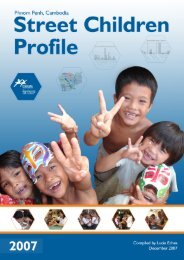Download - Friends International
Download - Friends International
Download - Friends International
You also want an ePaper? Increase the reach of your titles
YUMPU automatically turns print PDFs into web optimized ePapers that Google loves.
other young people. According to WHO, factors which might contribute to vulnerability<br />
include: malnutrition; poor hygiene/sanitation; lack of shelter; violence; and emotional/<br />
social deprivation 31 .<br />
Another important health issue is HIV/AIDS; however, Cambodia is one of the few<br />
countries that have seen declining HIV prevalence reducing the adult rate (15-49 years<br />
of age) from 3 percent in 1997 to 0.8 percent in 2008 32 . Cambodia’s HIV/AIDS epidemic is<br />
spread primarily through heterosexual transmission and revolves largely around the sex<br />
trade. Significantly, a low prevalence rate in the general population masks far higher prevalence<br />
rates in certain sub-populations, such as injecting drug users, people in prostitution, men who<br />
have sex with men, karaoke hostesses and beer girls, and mobile and migrant populations.<br />
As a consequence of the high HIV/AIDS prevalence during the 1990s the number of<br />
AIDS or-phans has increased in Cambodia at a proportional rate in the recent years.<br />
Children/youth whose parents are living with HIV often experience many negative<br />
changes in their lives even before they are orphaned. Eventually, they suffer the death<br />
of their parent(s) and the emotional trauma that results. They may then have to adjust<br />
to a new situation, with little or no support, and are at risk of ending up on the streets.<br />
In response, the National HIV/AIDS Authority of Cambodia has shifted the focus of<br />
its prevention efforts from young adults to children. 2008 statistics show an increase<br />
in rates of antiretroviral use among children and mother-to-child transmission of the<br />
virus.<br />
Unsafe Migration Patterns and Human Trafficking<br />
Migration within Cambodia is primarily internal, rural-urban, and the movement is<br />
usually to-wards more prosperous areas.<br />
According to the National Institute of<br />
Statistics of Cambodia, 35 percent of the<br />
Cambodian population are migrants 33 .<br />
Although migrants are conventionally<br />
thought of as adults or families, several<br />
street children/youth are lone migrants. It<br />
is observed that youth (aged 15-24) form<br />
CSCN<br />
CSCN Street Children Profile 2009<br />
21






